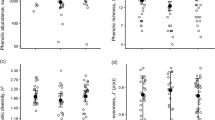Abstract
Preferences of meadow voles (Microtus pennsylvanicus) toward various coniferous species were tested under winter conditions. Cafeteria tests showed preferences for Norway spruce (Picea abies) and Norway pine (Pinus resinosa) and rejection of white pine (Pinus strobus) and white spruce (Picea glauca). When phenolic extracts of these species were prepared and added to a low 8% protein diet, food intake of voles and preferences by rank followed the same patterns. Determination of the concentration of phenolics in branch samples using the Singleton and Rossi procedure showed that Norway pines contained the smallest amount (2.15%/g dry matter) while spruces yielded the most (2.76%/g dry matter). These experiments lead us to expect high losses of Norway pine and Norway spruce in habitats harboring high vole densities.
Similar content being viewed by others
References
Bergeron, J.-M., andJodoin, L. 1987. Defining “high quality” food resources of herbivores: The case for meadow voles (Microtus pennsylvanicus).Oecologia 71:510–517.
Bergeron, J.-M., andTardif, J. 1988. Winter browsing preferences of snowshoe hares for coniferous seedlings and its implication in large-scale reforestation programs.Can. J, For. Res. 18:280–282.
Bryant, J.P. 1981. Phytochemical deterrence of snowshoe hare browsing by adventitious shoots of four Alaskan trees.Science 213:889–890.
Bryant, J.P., andKuropat, P. 1981. Antiherbivores defense patterns of taiga forest trees and shrubs. Proceedings of the 32nd Alaska Science Meeting, Fairbanks, Alaska, Aug. 25–27.
Byers, R.E. 1974. Susceptibility of apple and peach stems to attack by pine voles.Hortic. Sci. 9:90–91.
Green, J.E. 1978. Techniques for the control of small mammals damage to plants: A review. Alberta Oil Sands Environmental Research Report No. 38. 11pp.
Hansson, L. 1985. Damage by wildlife, especially small rodents, to North AmericanPinus contorta provenances introduced into Sweden.Can. J. For. Res. 15:1167–1171.
Harper, P., andHarestad, A.S. 1986. Vole damage to coniferous trees on Texada Island.For. Chron. 62:429–432.
Lindroth, R.L., andBatzli, G.O. 1984. Plant phenolics as chemical defenses: Effects of natural phenolics on survival and growth of prairie voles (Microtus agrestis).J. Chem. Ecol. 10:229–237.
Lindroth, R.L., Batzli, G.O., andAvildsen, S.I. 1986.Lespedeza phenolics andPenstemon alkaloids: Effects on digestion efficiencies and growth of voles.J. Chem. Ecol. 12:713–728.
Palo, R.T. 1984. Distribution of birch (Betula spp.), willow (Salix spp.) and poplar (Populus spp.) secondary metabolites and their potential role as chemical defense against herbivores.J. Chem. Ecol. 10:499–520.
Sas Institute, Inc. 1985. SAS User's Guide: Statistics, 5th edition. Cary, North Carolina.
Sinclair, A.R.E., Krebs, C.J., andSmith, J.N.M. 1982. Diet quality and food limitation in herbivores: The case of the snowshoe hare.Can. J. Zool. 60:889–897.
Singleton, V.L., andRossi, J.A. 1966. Colorimetry of total phenolics with phosphomolybdic-phosphotungstic acid reagents.Am. J. Ecol. Vitic. 16:144–158.
Sullivan, T.P., andVyse, A. 1987. Impact of red squirrel feeding damage on spaced stands of lodgepole pine in the Cariboo region of British Columbia.Can. J. For. Res. 17:666–674.
Tahvanainen, J., Helle, E., Julkunen-Tiitto, R., andLavola, A. 1985. Phenolic compounds of willow bark as deterrents against feeding by mountain hare.Oecologia 65:319–323.
Whittaker, R.H., andFeeny, R.G. 1971. Allelochemics: Chemical interaction between species.Science 171:757–770.
Wysolmerski, J.C., Byers, R.E., andCummings, J.N. 1980. Laboratory evaluation of someMalus clones for susceptibility to girdling by pine voles.J. Am. Hortic. Sci. 105:675–677.
Author information
Authors and Affiliations
Rights and permissions
About this article
Cite this article
Roy, J., Bergeron, J.M. Role of phenolics of coniferous trees as deterrents against debarking behavior of meadow voles (Microtus pennsylvanicus). J Chem Ecol 16, 801–808 (1990). https://doi.org/10.1007/BF01016490
Accepted:
Issue Date:
DOI: https://doi.org/10.1007/BF01016490




